Are you worried about your chicken’s care during the winter months? As chicken keepers, this can be scary, especially for those who live in parts of the country where it can be harsh. Many chicken owners have concerns about how a chicken can survive ice-cold conditions. Will they freeze to death? Can they get frostbite? Do they need different food? Does the coop need to be heated? Do your chickens need artificial lights? Are they allowed to go outdoors?
Learn how to care for them properly and tips for raising chickens in the cold to frigid weather without going overboard. We’ll take the worry out of chicken care in the winter months with you.
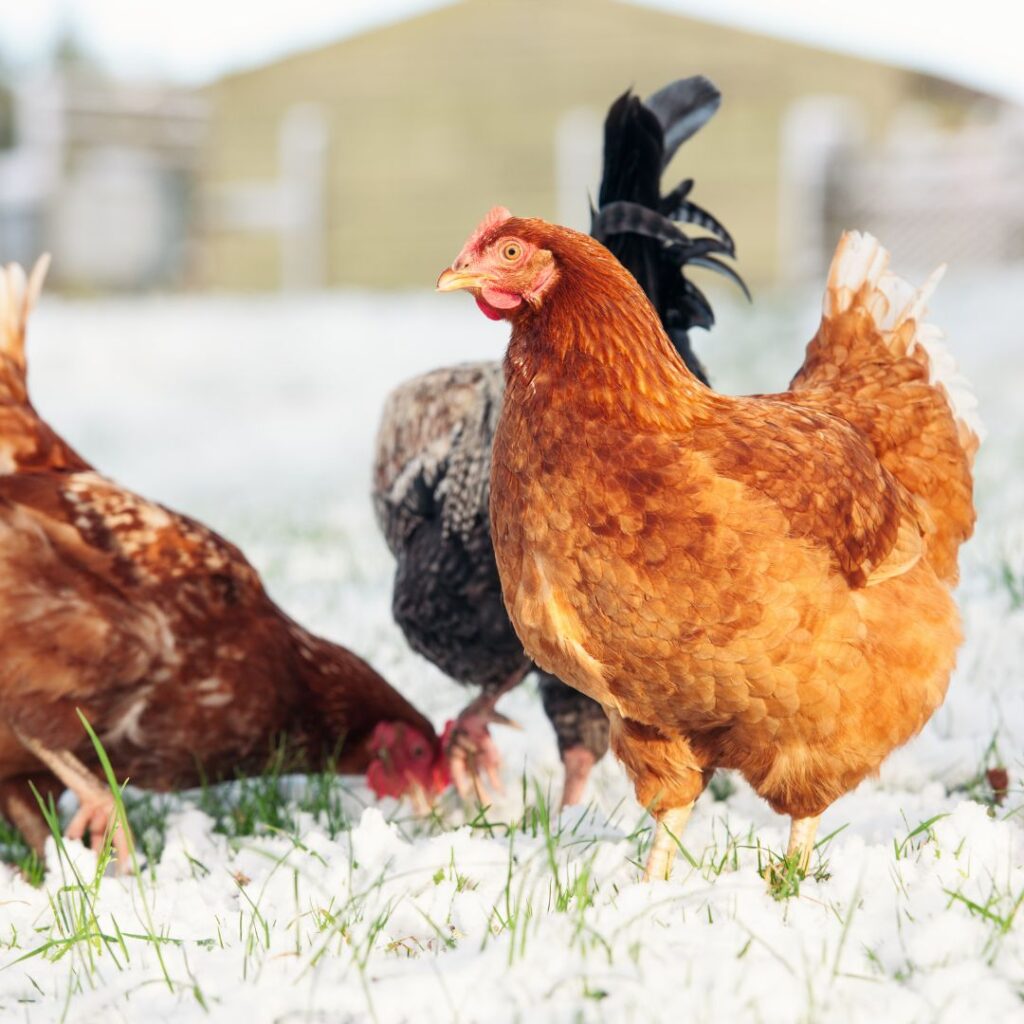
We are going to first cover the chicken coop, insulation, ventilation for airflow, drafts, humidity, bedding/ litter, flock body heat, artificial lights or not, and the essentials you’ll need indoors.
Next up we’ll go over the outdoors, a protected run area, can chickens free range in the winter, and snow.
Of course, you’ll also learn about feeding needs and nutrition during the winter months, treats, treats that decrease boredom and stress in your flock.
Chickens are tough and can handle cold temperatures without any problem! You’re about to learn just how raising chickens and keeping chickens in cold temperatures can be done.
Preparing and Securing the Coop for Cold Temperatures
1) Seal Up and Prevent Cold Drafts
One way to keep your birds warm and healthy during winter is to prevent cold drafts. This can be easily done by using a few simple strategies.
A good chicken coop should already have a waterproof roof and proper ventilation. If it doesn’t, you can fix this fairly easily. You can use Tyvek material to wrap the coop, or tarp plastic sheeting to prevent drafts inside the coop.
By doing this, you’ll ensure that they keep warm winter long!
It’s worth mentioning, that some people use hay or straw bales for insulation. We haven’t found this necessary with proper construction and wrapping, but you may find this a useful technique.
2) Maintain Good Coop Ventilation
Maintaining good coop ventilation is one of the most important things to remember when keeping chickens in the winter. This will help keep the airflow inside the coop from becoming stagnant and damp, which can lead to respiratory problems for your chickens.
It’s also important to ensure that vents are located near the top of the coop, well above where chickens roost. This will allow fresh air to circulate through the hen house, preventing cold drafts from blowing on your birds.
Ensure that the ventilation openings are in a good location so that moisture doesn’t build up inside the coop. Maintaining good ventilation is important during the winter. Venting should be near the top of the coop so that moisture doesn’t build up and cause your chickens to become sick.
It’s also important to prevent cold drafts from blowing on your chickens, making them uncomfortable. One easy way to do this is by using a vent deflector. A vent deflector is simply a piece of cardboard or metal that you place over the vent opening to direct the airflow away from your chickens.
Proper air flow will also help keep chicken coops cool in the summer.
Winter chicken coop preparation is key to keeping your flock healthy and thriving during the harsh weather.
Some breeds of chicken cannot handle winter as well as others. Other breeds can handle colder temperatures, but they need some sort of natural heat source in the coop to maintain their body temperature. If you live in a cold climate, choosing a breed of chicken appropriate for your climate is important.

3) Add Additional Insulation for Good Measure
It is important to add insulation to your chicken coop in cold climates. Insulation will help create thermal mass and prevent the cold from getting in. In addition, adding insulation can help improve the overall temperature of a coop.
There are many ways to add insulation to a coop. One way is to use foam board or Styrofoam panels. These materials are easy to install and will help reduce heating costs in the wintertime. the better option is to button up the outside by wrapping in Tyvek or similar wrap. It’s easily installed not terribly expensive, and will guard against drafts in the winter, bugs, and excessive heat in the summer.
You should be all set if your coop is already constructed using this material. You can go inside on a sunny day and if you see daylight peeking through, you know you have spots to secure.
4) Deep Litter Method; Natural Source of Warmth and Insulation
If you are looking for an alternative to regular cleaning, consider using the deep litter method during the cold winter months. This provides insulation and helps improve the overall temperature of a coop. This method involves leaving a layer of bedding (usually hay or straw) on the coop’s floor and letting it decompose over time.
Once a week, you will need to go in with a shovel or a pitchfork and turn the litter. Then add a layer of clean straw or hay to the top. Doing this weekly allows the under-layer to start to decompose and reduce an ammonia build-up or mold to form.
The natural heat from the droppings and decomposing process will help provide warmth for your chickens in the winter.
This method does not require regular full cleaning but should be done every few months to maintain optimal conditions for your chickens in the winter.
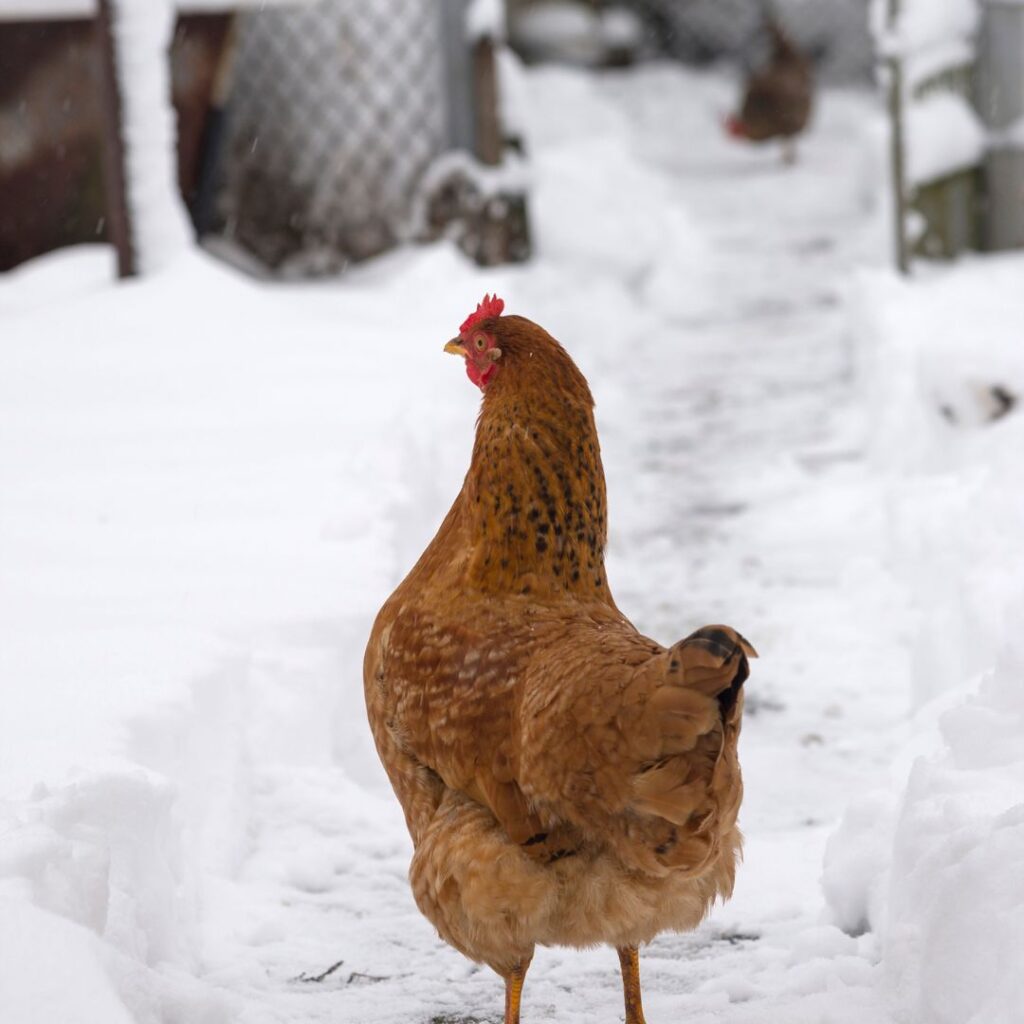
5) Monitor the Temperature and Humidity for Peace of Mind
Keeping an eye on the temperature and humidity in your coop is a good way to make sure your chickens are staying healthy as well as stay warm during winter. You can use a thermometer like this one to get the accurate temperature and humidity readings.
If you’re using the deep litter method to insulate your coop, it’s important to ensure you’re managing it properly. One way to do this is by regularly adding fresh bedding material to keep the coop clean and well-insulated. If you aren’t doing this weekly, the humidity level can rise too much, causing a risk of bacteria and respiratory issues with the flock.
6) Roosts Help with Warmth and a Good Night’s Sleep
Chickens need a place to sleep at night, where roosts come in. You’ll want to ensure your coop is equipped with them, as they help keep your chickens comfortable and stay warm during the winter.
Winter roosting is important for body heat, so a roost where chickens can be closer together is preferred.
The height of the roost will depend on the size of your coop, but at least one above the ground is generally recommended.
Chickens’ natural footing prefers a rounded corner on the roost A wide board is good as long as you round off the corners. If you find an old wooden step ladder that you can deconstruct, that would be a great option to lean securely against the coop wall.
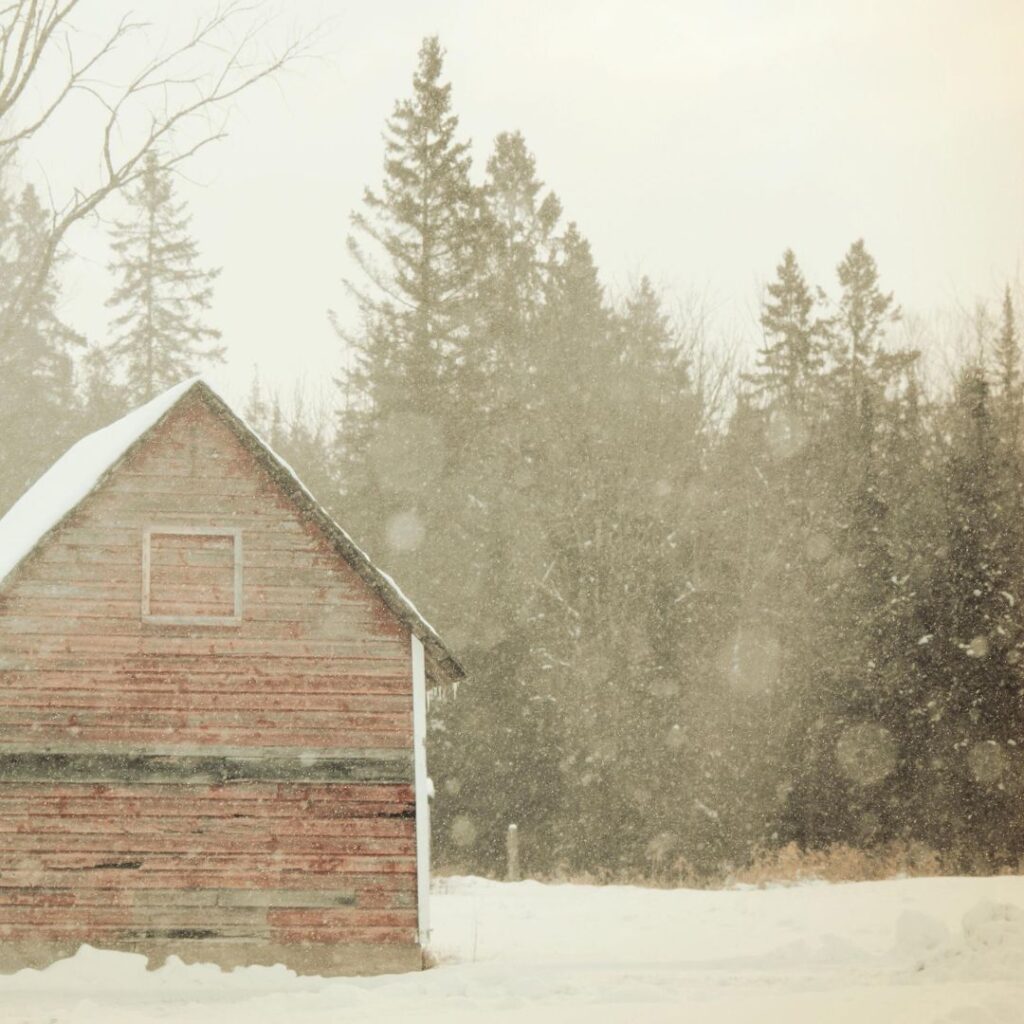
7) Providing the Essential Indoors
Chickens need food and water to stay healthy, so it’s important to provide them with a fresh supply of both indoors. In the winter, some chickens may not want to go outside because they’re scared of the weather or don’t feel safe. They will consume more in the winter months, so you’ll want to either have larger containers or refill more frequently.
Do NOT: Do Not add an artificial Heat lamp. This can be unsafe for your birds and increase fire hazard risks. Heat lamps have their purpose when chicks are new and unfeathered. We never recommend having baby chicks over the winter months and strongly advise against artificial heat sources in or outside the coop in the winter months.
An unhealthy warm temperature inside a coop could also increase respiratory problems in your flock. Just don’t do it!
Wish List: If you haven’t yet constructed your coop and can build one with a window for natural lighting, that would be a luxury and a delight for your flock. It may even help your chickens lay eggs. (more on this later)

The Chicken Run
8) Provide a Protected Outdoor Space
Your chickens need a place to play, so ensure you provide them with an outdoor space covered and protected from the elements. This way, they will have a safe place to go out and relax or burn some energy when it’s raining or snowing outside.
Hanging a protective covering in an area of the run will allow your chickens outdoors yet protect their feet from wet snow.
A tarp, lean-to area, tented area, or even constructing a DIY hoop house (like gardeners use) will provide a dry, warm outdoor space for the chickens that can help keep them healthy and comfortable during the colder weather.
Remember, more daylight hours could help your hen increase egg production.
Related: Read About The Brahma Hens and Roosters Here
9) Free Range Flocks In the Winter Months
Many chickens love a winter stroll. While they won’t find much to forage for, you can toss some scratch or cracked corn in an area for them. They usually don’t mind the snow, just not when it is actively snowing, sleeting, or raining. If you have a free-range flock, feel free to let them roam as you usually would.
As chicken owners, it can be quite entertaining watching your birds outdoors as you’re shoveling and doing your winter chores.
Benefit: The extended daylight out of the coop may help with winter egg production.
Caution: Just be aware that some areas have different and hungrier predators in the winter months. Know your chicken’s surroundings for their safety. You may want to do an evening head count to be on the safe side.
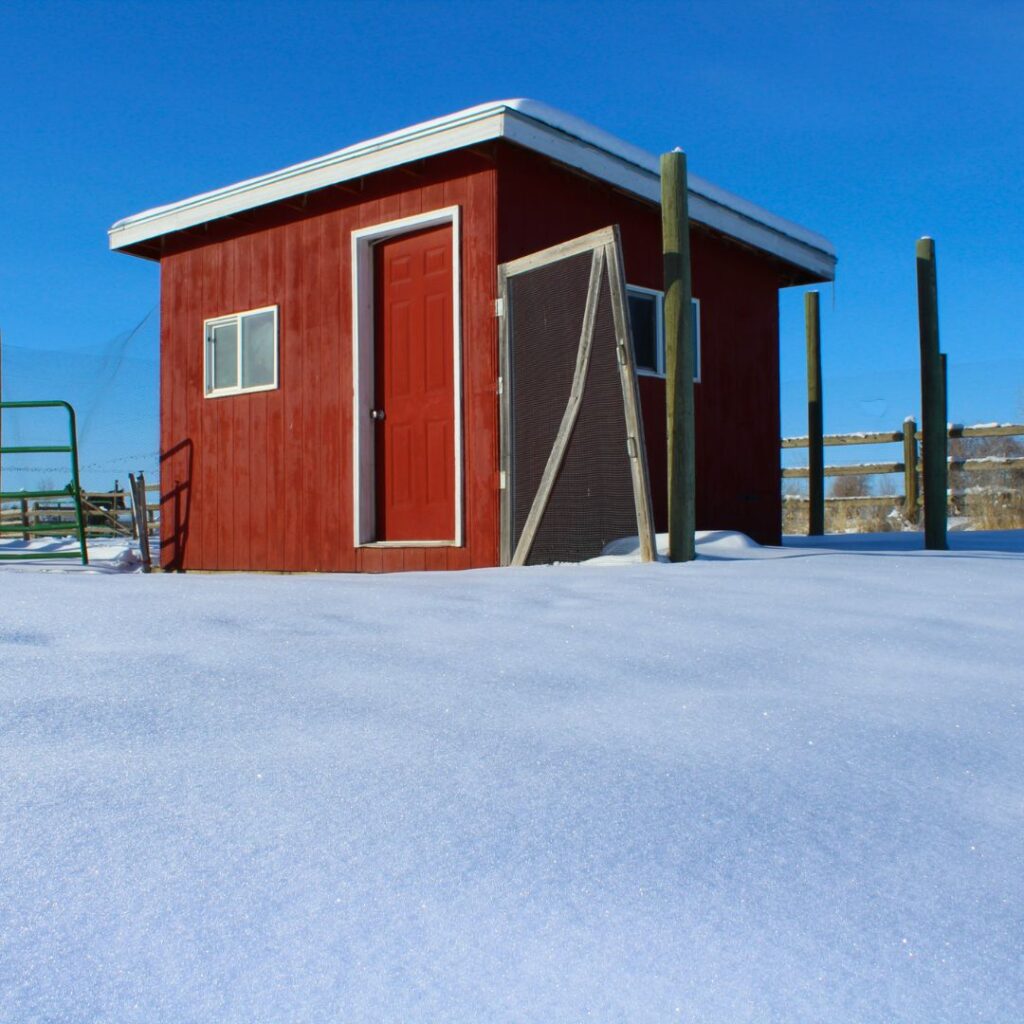
Care For Your Flock During The Winter
10) Watch Out for frostbite
Chickens are especially susceptible to frostbite during extreme winter conditions. Chickens that live in wet environments are also at risk for hypothermia since they have less body fat to protect them from low temperatures. The comb and wattles are the most vulnerable parts of a chicken to frostbite.
The wind chill is especially dangerous for chickens living in wet conditions The frostbitten areas are the comb, wattles, and occasionally the feet. Petroleum Jelly on their combs and wattles will help prevent frostbite with your chickens.
Chicken owners also rave about Musher’s Secret Dog Paw Wax as even better than petroleum. A little bit goes a long way!
11) make sure their water doesn’t freeze
Ways to prevent your chickens’ water from freezing during the winter:
Keeping chickens’ water from freezing during the winter can be a challenge. However, having a fresh supply of water is important to their survival.
It is important to keep the waterer inside the coop, as it will be warmer than the outside. If you run a water line during the warmer months, this may not work in the winter. You could risk frozen pipe/hose line, which could put your birds at risk of severe frostbite and put you in serious debt.
You may need to bring out fresh water several times a day. Chickens need a steady supply of fresh water.
There are also bowl warmers and heated waterers as long as you have a safe, reliable power source for your coop. Many recommend a black bowl, which will retain heat better if you’re using a bowl.
The two waterers we prefer are a bit pricey but have decent capacity and are designed for multiple chickens. This heater waterer holds up to 2 gallons and can accommodate up to 15 chickens. This is adequate for most backyard chicken keepers. This second heated waterer holds up to 3 gallons and can accommodate up to 35 chickens. We like the detachable cord option on this for year-round use.
While purchasing a heated waterer is an expense, it will give you peace of mind, allow a fresh water source, and means fewer trips back and forth to the chicken coop when it’s below zero. Absolutely not necessary. We have gone for years only manually changing out water (gripingly but successfully).
Whatever method you choose, make sure you take steps to keep chickens’ water fresh, clean, and available all winter long!
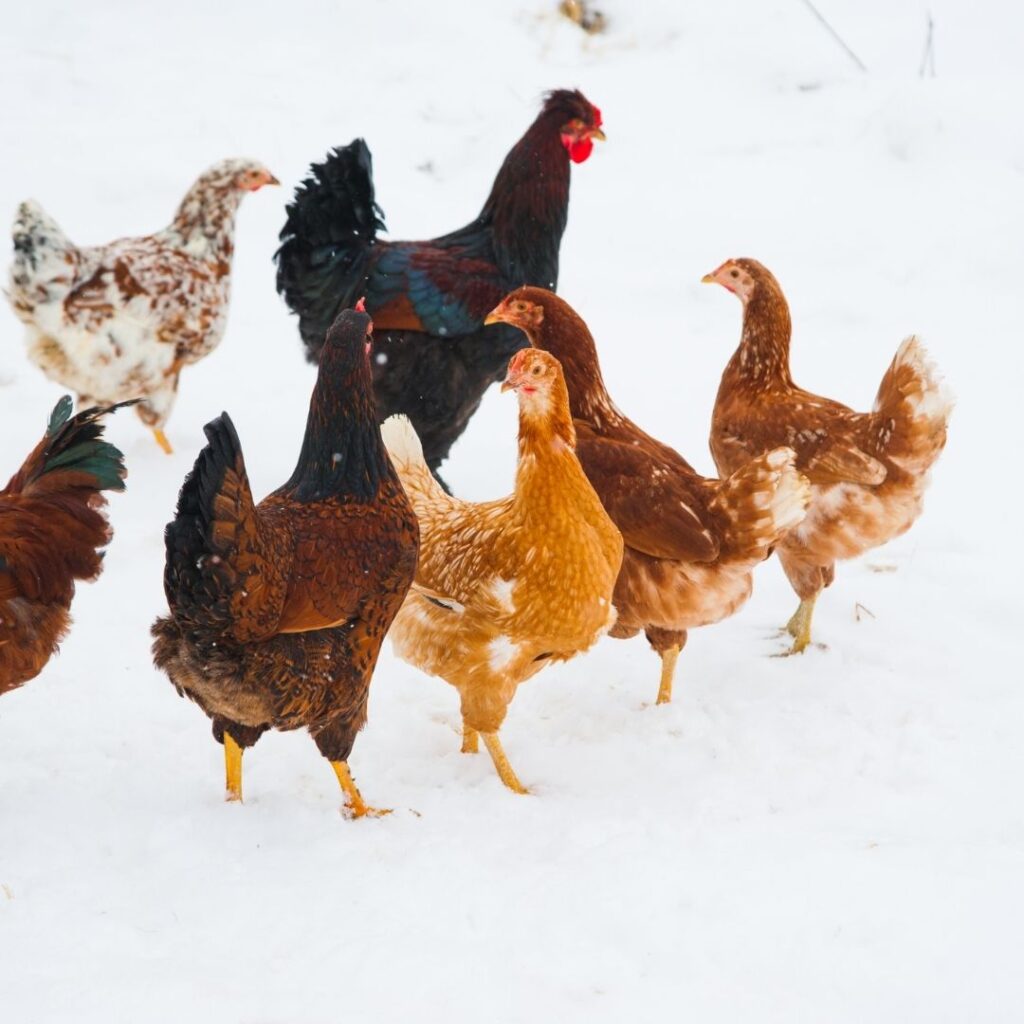
12)Increase Protein and Feed Needs
Your hens won’t stop laying eggs completely but will greatly reduce. If you have a good number of hens molting (most do around the winter months) It’s a good idea to increase their protein and decrease their calcium.
Protein should be closer to 18%. 20% is o.k. for winter only but this is typically what is fed to meat birds for increased muscle growth. As it’s winter, you want your hens to have that added bulk without adding unhealthy amounts of fat.
All chickens will have increased appetites and consume more food. Be sure to increase your feed purchase when the days get shorter and the temperatures dip.
note: Normal protein levels for a laying hen in non-winter months is 16-18%.
Consult with your local feed and grain/ farm supply store for the best feed for your flock.
13) warm food and treats
Warm Chicken Treats
- A good pot of cooked oatmeal (add dried or fresh fruits)
- Home Made Apple sauce. you can even keep the skin on!
- Cooked Squash, Pumpkin, Carrots, and oven-baked sweet potatoes!
- Pot of vegetable soup, split pea soup (made with scrap veggies.. your chickens are not food critics). No salt added, please, and thank you.
- Boiled, roasted, baked cabbage
- Cooked beans
Other chicken treats
- Cracked corn
- Grits
- Safflower Seeds
- Sunflower Seeds
- Seed Bocks (aka Flock Block or Scratch Block)
- Suet Cakes
- Dried Meal Worms (you can find Suet cakes with meal worms too)
- Treat Balls, Treat Baskets and Treat Bags
Proper food intake will help your chicken maintain their health and warmth throughout the winter climate and enter into spring with better egg production for your hens.
Always remember that 10% treats is the maximum recommended to 90% of their grain when feeding chickens in the winter.

other winter considerations
Age & Breed of Chicken
There are different age and breed considerations you should keep in mind when keeping chickens. Adult chickens can keep themselves warm and chicks cannot.
We do recommend you get a breed that does well in your part of the country. There are some great egg-laying cold hardy chickens to choose from.
Some of the cold-hardy birds that backyard chicken owners prefer are:
- Rhode Island Reds
- Chanteclar
- Cochin
- Delaware Chickens
- Easter Eggers
- Australorp
- New Hampshire Red
- Jersey Black Giant Chicken
Read our full list of cold hardy backyard chickens here.
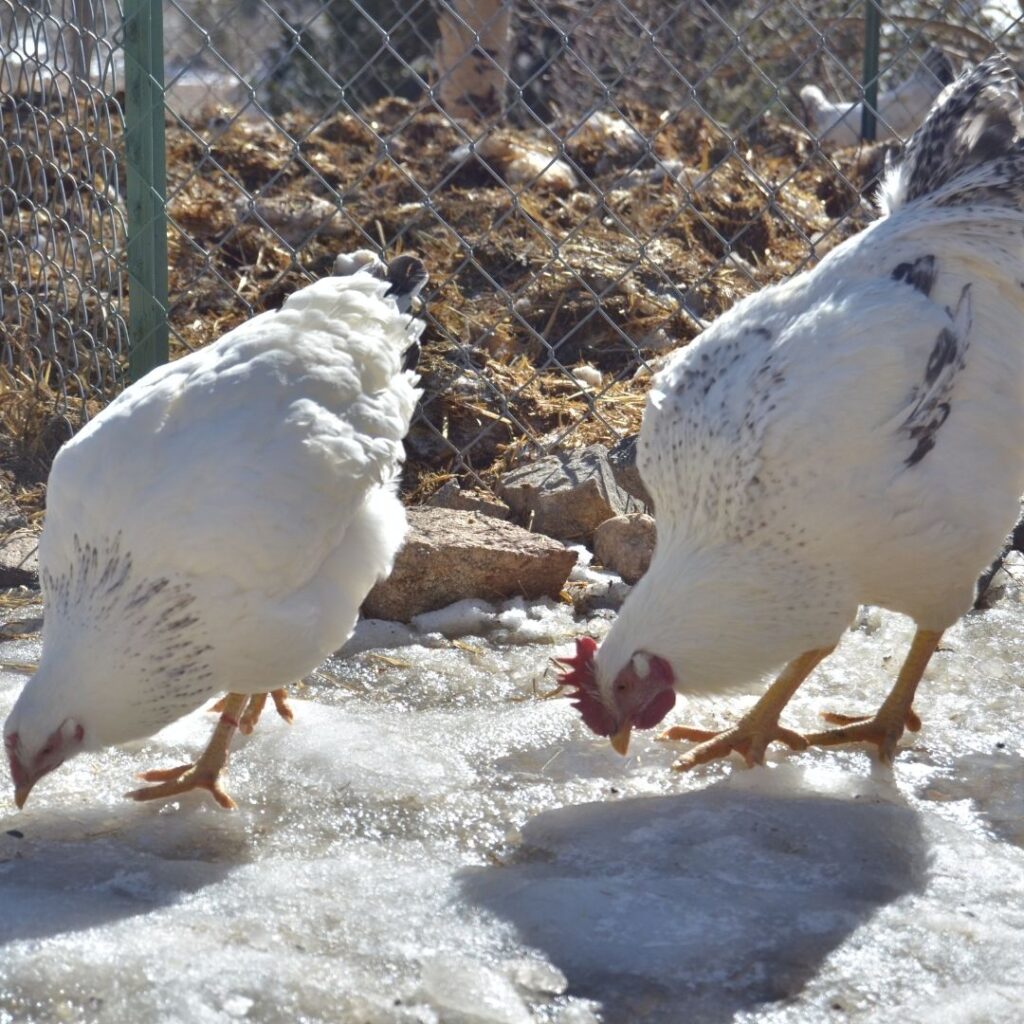
Egg Production in Winter
During winter, the days are shorter, and there is less light. This can cause egg production to decline because egg-laying chickens need sunlight to produce eggs. In addition, chickens need a break from laying eggs during winter to save their energy for other things like staying warm.
Related Article: How Long Do Chickens Lay Eggs and Their Average Life Expectancy.
Related: Reasons Chickens Stop Laying Eggs here.
If you try to trick their bodies into laying in the winter months, you’ll stress your hen’s metabolism, stress their health in general, and shorten your bird’s life. It’s just not natural for them to lay eggs regularly on shorter winter days. Hens stop laying and start back up for most chicken keepers every year. Don’t stress about it.
We understand you want the freshness of your backyard eggs year-round. You can preserve your fresh eggs by freezing them in the spring/summer months. Read more about that here.
If you do get the occasional egg, and it freezes, discard the egg promptly. Once the shell cracks, it’s contaminated and not safe to eat. Learn more about the care of fresh backyard eggs here.
How can you get your chickens to lay eggs in winter?
In the winter, chickens may stop producing eggs or lay much less often than in the spring/summer. This is because the days are shorter and there is less sunlight.
If your hens stop laying for a couple or a few months, don’t worry. As long as they are eating well, and appear otherwise healthy, they’ll start laying eggs again come spring.
Commercial chicken farms stimulate egg laying by providing certain manufactured conditions. One of those ways is to add artificial lighting. While we don’t recommend this for the overall well-being of your flock, we acknowledge this is standard practice for some who rely on the financial support of their hens’ eggs.
Related Reading: Raising Backyard Chickens; Tips for Beginners
What is the best way to protect chickens from the Cold Weather?
Simply keep them in a warm, safe place with plenty of water and food. Read all our tips above and you’ll have a great backyard flock of egg-laying hens come spring.
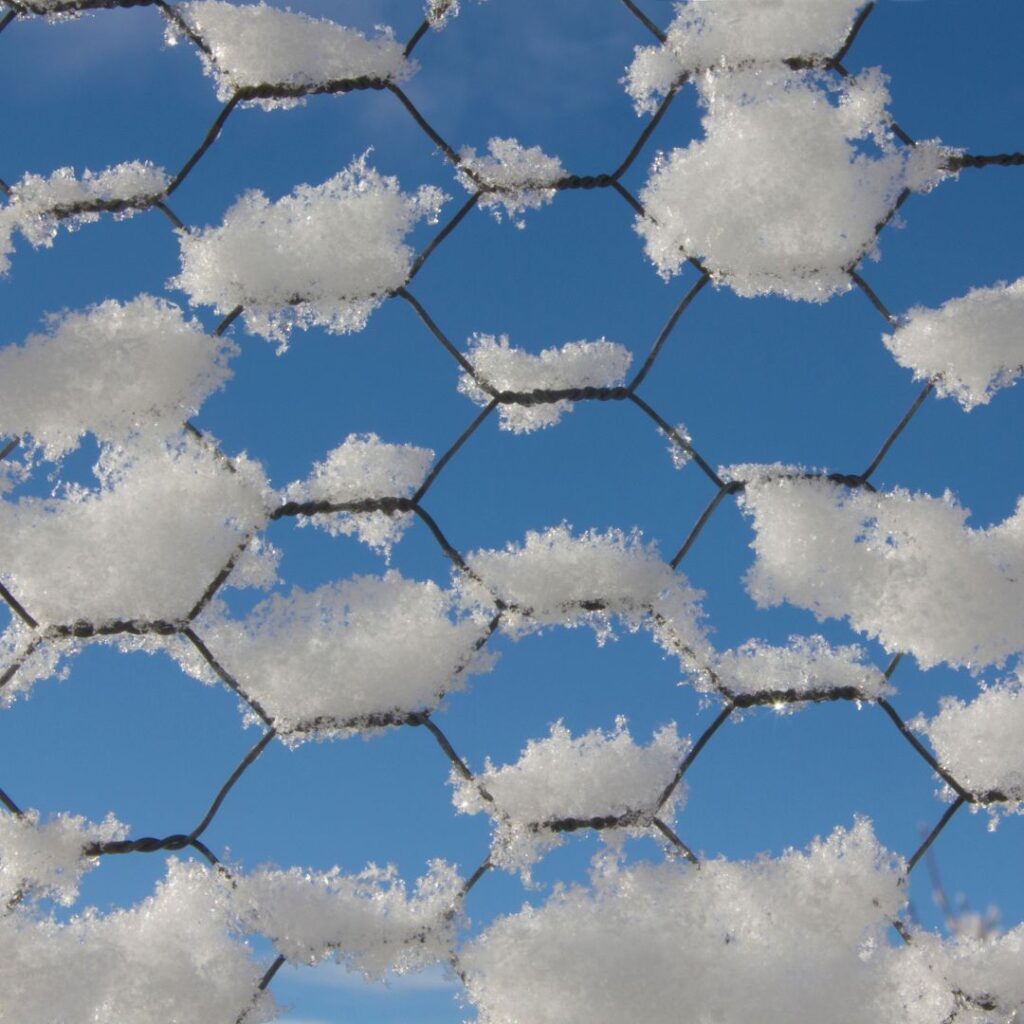
Final Thoughts on Chicken Care During the Winter
When the weather gets cold, it’s important to ensure your chicken coop is ready for winter. Chickens can live in temperatures below zero without supplemental heat, but they will be much more comfortable if you provide them with a warm place to stay. There are several things you can do to prepare your chicken coop for winter weather:
Make sure your chicken coop has the proper insulation. This can be done by adding extra insulation materials like straw, hay, or leaves.
Now you know the secrets backyard chicken owners have to keep chickens in the winter is keeping your chickens warm, happy, and healthy in winter.
Chickens can acclimate to colder climates, so don’t be afraid to keep them outside during winter. You should not use fire as a heating option, as it could potentially burn your chickens or start a fire. Chickens can continue to lay eggs during the winter, although production may slow down some. Finally, remember that all chickens will undergo molting in the winter. Some breeds are more resistant to cold weather than others.
Ask your local farm store for advice if you have any questions about keeping your chickens warm in winter.
Preparing your chicken coops for winter weather is always worth the time and effort in the long run.
Having all this talk about the cold and wintery days ahead, take a few minutes to plan your summer with easy tips on how to attract hummingbirds to your backyard.
Check out our article on pet-friendly lawns (dog-friendly grasses).
Looking For A Unique Blue Egg Layer? Check Out Our Article On The Araucana Chicken.
Find Out About The Cochin Chicken Breed Here.
If you want to start with a small chicken, consider looking into a Mille Fleur D’Uccle Bantam Breed.


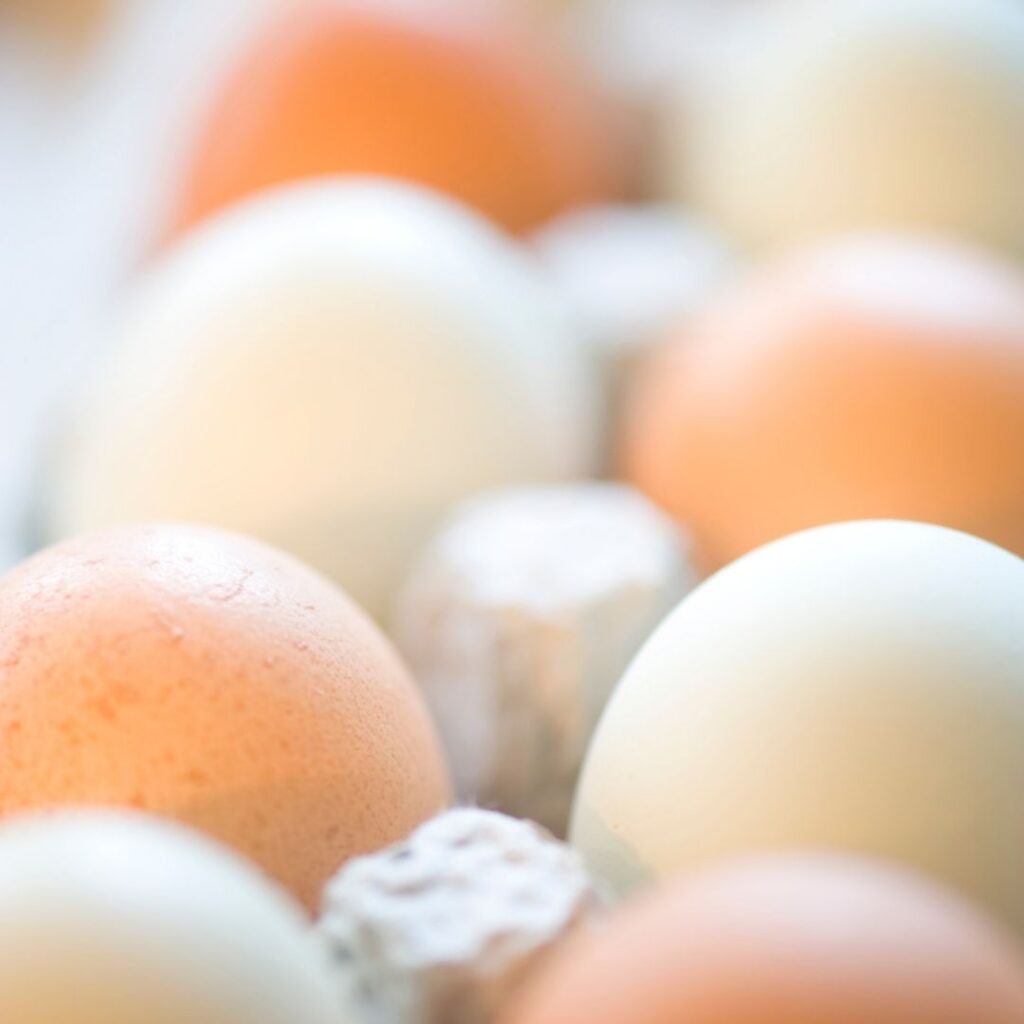

Pingback: Raising Backyard Chickens; Tips For Beginners - Gilmore's
Pingback: How Many Eggs Do Chickens Lay? This May Surprise You! - Gilmore's
Pingback: How To Attract Hummingbirds To Your Yard in 2022 - Gilmore's
Pingback: How long do chickens lay eggs? Age, Production, and More! - Gilmore's